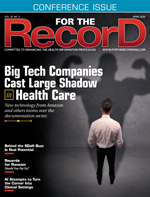April  2020
2020
Inside Interoperability: The Expedition to Realize Interoperability
By Mariann Yeager
For The Record
Vol. 32 No. 3 P. 26
Although challenges remain, the industry is making strides toward health information interoperability.
As we are already a few months into 2020, I’d like to share perspectives regarding interoperability’s progress to date and important developments that will shape 2020 and beyond. Interoperability has been a hot topic for a while now and continues to enjoy high visibility in the media, with sharp focus from policy makers and health care leaders.
The sector’s progress is encouraging. There is a clear destination in mind—seamless sharing of valuable, meaningful, and timely health information nationwide. The industry has a path for making progress, connecting health care organizations, health plans, public health, and others to health information networks and interconnecting those networks at an unprecedented scale. The volume of information being exchanged is growing at exponential rates and will continue this upward trajectory.
Of course, there are challenges that need to be addressed along the way. Namely, it’s important to improve patient matching and the consistency and usability of health data.
As the industry looks forward and charts a course, there are a number of new and evolving developments that will shape the path.
Final Regulations and Active Work on Public Policies
While 2019 saw a multitude of draft regulatory and other public policy proposals, 2020 is poised to be the year in which the industry sees movement. Expect final rules for the Centers for Medicare & Medicaid Services’ Interoperability and Patient Access Rule and the Office of the National Coordinator for Health Information Technology (ONC) Rule to Improve the Interoperability of Health Information. In addition, expect ongoing Congressional work on Cures 2.0 and health information privacy, implementation of Health and Human Services’ (HHS) draft HIT strategy and recent burden reduction report, as well as work on surprise billing and transparency.
This dynamic public policy environment will have significant impact on the HIT community, including developers of HIT systems, health information networks, and users of those systems and networks. There will be much to sort out in the coming year.
Fortunately, there are a number of organizations well poised to help make sense of these rapid changes. For example, The Sequoia Project’s public-private cooperative, Interoperability Matters, engages experts from across the health care and HIT communities to identify, prioritize, and collaborate on the most pressing, discrete challenges to nationwide health information sharing.
In advance of the expected publication of final information blocking rules, the Interoperability Matters Information Blocking Work Group released “Guidance to the Community and Implementation Feedback to HHS,” which addresses implementation-related aspects of priority components of the information blocking regulation, including the following:
• regulatory definitions such as those for health information exchange and health information network;
• information blocking practices;
• recovering costs/licensing exceptions; and
• compliance and implementation plans.
Continued Expansion of PULSE
The devastating fires in California and Hurricanes Florence and Michael in 2018 showed that disasters are unpredictable and disruptive and place unique demands on public health, private sector health care, first responders, and other key resources. Providing disaster response health care workers access to timely health information has a meaningful impact on treating people who have to receive care outside of the normal health care delivery system during natural disasters.
The Patient Unified Lookup System for Emergencies (PULSE), deployed in 2018, enables health care volunteers to access patient health information to treat individuals during natural disasters. PULSE, which leverages the existing backbone of health information networks, has been successfully implemented in California and will be expanded to Florida and Texas in the near future. PULSE is supported by Sequoia as a public-private initiative that includes HHS, the Office of the Assistant Secretary for Preparedness and Response, and various state agencies.
TEFCA/RCE
In 2019, The Sequoia Project was selected to serve as ONC’s Trusted Exchange Framework and Common Agreement (TEFCA) Recognized Coordinating Entity (RCE). In this capacity, the RCE is responsible for developing, implementing, and maintaining the Common Agreement component of TEFCA. In addition to the Common Agreement, the RCE will collaborate with ONC to designate and monitor qualified health information networks (QHINs), modify and update an accompanying QHIN Technical Framework, engage with stakeholders through public feedback sessions, adjudicate noncompliance with the Common Agreement, and propose sustainability strategies to support TEFCA beyond the cooperative agreement’s period of performance.
By providing a unifying framework and use cases for nationwide exchange among health information networks, this work presents an opportunity to shape the future of interoperable health information sharing.
Nationwide Health Information Exchange (a Reality!)
There has been exponential growth in health information network participation as well as volumes of records exchanged among networks. Carequality, for example, reports that an estimated 600,000 physicians share more than 90 million clinical documents each month across and among disparate networks. Heath information sharing on a nationwide scale is not only attainable but also a practical reality.
Improving the Consistency, Usability, and Quality of Health Information
The health care sector has made tremendous strides in expanding connectivity and increasing health information exchange. This leads to increased reliance on electronic health information and the expectations that these data are both usable and valuable. The exchange of usable and valuable information should be the principal focus for the HIT community in 2020.
Change Is Constant, and the Future Is Bright
There’s been a seismic shift toward greater interoperability; expect that momentum to continue. Progress is tangible and challenges are surmountable. The more the industry focuses on understanding and addressing the most pressing issues of our time, the more likely it will advance HIT in a thoughtful, impactful manner.
This is a pivotal time for interoperability. Press on.
— Mariann Yeager is CEO of The Sequoia Project, which advocates for nationwide health information exchange.



